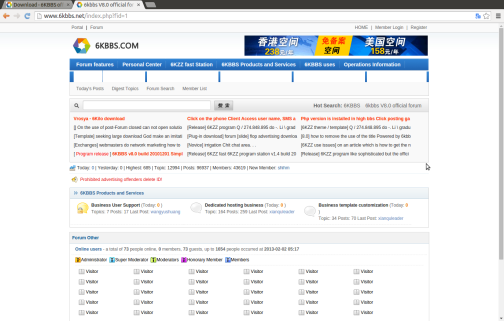CXSecurity WLB-2015040034 6kbbs v8.0 Multiple CSRF (Cross-Site Request Forgery) Web Security Vulnerabilities
Exploit Title: 6kbbs Multiple CSRF (Cross-Site Request Forgery) Security Vulnerabilities
Vendor: 6kbbs
Product: 6kbbs
Vulnerable Versions: v7.1 v8.0
Tested Version: v7.1 v8.0
Advisory Publication: April 02, 2015
Latest Update: April 02, 2015
Vulnerability Type: Cross-Site Request Forgery (CSRF) [CWE-352]
CVE Reference: *
CXSecurity Reference: WLB-2015040034
Impact CVSS Severity (version 2.0):
CVSS v2 Base Score: 6.8 (MEDIUM) (AV:N/AC:M/Au:N/C:P/I:P/A:P) (legend)
Impact Subscore: 6.4
Exploitability Subscore: 8.6
CVSS Version 2 Metrics:
Access Vector: Network exploitable; Victim must voluntarily interact with attack mechanism
Access Complexity: Medium
Authentication: Not required to exploit
Impact Type: Allows unauthorized disclosure of information; Allows unauthorized modification; Allows disruption of service
Writer and Reporter: Jing Wang, Division of Mathematical Sciences (MAS), School of Physical and Mathematical Sciences (SPMS), Nanyang Technological University (NTU), Singapore. (@justqdjing)
Suggestion Details:
(1) Vendor & Product Description:
Vendor:
6kbbs
Product & Vulnerable Versions:
6kbbs
v7.1
v8.0
Vendor URL & download:
6kbbs can be gain from here,
http://www.6kbbs.com/download.html
http://en.sourceforge.jp/projects/sfnet_buzhang/downloads/6kbbs.zip/
Product Introduction Overview:
“6kbbs V8.0 is a PHP + MySQL built using high-performance forum, has the code simple, easy to use, powerful, fast and so on. It is an excellent community forum program. The program is simple but not simple; fast, small; Interface generous and good scalability; functional and practical pursuing superior performance, good interface, the user’s preferred utility functions.”
“1, using XHTML + CSS architecture, so that the structure of the page, saving transmission static page code, but also easy to modify the interface, more in line with WEB standards; 2, the Forum adopted Cookies, Session, Application and other technical data cache on the forum, reducing access to the database to improve the performance of the Forum. Can carry more users simultaneously access; 3, the data points table function, reduce the burden on the amount of data when accessing the database; 4, support for multi-skin style switching function; 5, the use of RSS technology to support subscriptions forum posts, recent posts, user’s posts; 6, the display frame mode + tablet mode, the user can choose according to their own preferences to; 7. forum page optimization keyword search, so the forum more easily indexed by search engines; 8, extension, for our friends to provide a forum for a broad expansion of space services; 9, webmasters can add different top and bottom of the ad, depending on the layout; 10, post using HTML + UBB way the two editors, mutual conversion, compatible with each other; …”
(2) Vulnerability Details:
6kbbs web application has a computer cyber security bug problem. It can be exploited by CSRF (Cross-Site Request Forgery) attacks. This may allow an attacker to trick the victim into clicking on the image to take advantage of the trust relationship between the authenticated victim and the application. Such an attack could trick the victim into creating files that may then be called via a separate CSRF attack or possibly other means, and executed in the context of their session with the application, without further prompting or verification.
Several 6kbbs products 0-day vulnerabilities have been found by some other bug hunter researchers before. 6kbbs has patched some of them. Open Sourced Vulnerability Database (OSVDB) is an independent and open-sourced database. The goal of the project is to provide accurate, detailed, current, and unbiased technical information on security vulnerabilities. The project promotes greater, open collaboration between companies and individuals. It has published suggestions, advisories, solutions details related to csrf vulnerabilities.
(2.1) The first code programming flaw occurs at “/portalchannel_ajax.php?” page with “&id” and &code” parameters in HTTP $POST.
(2.2) The second code programming flaw occurs at “/admin.php?” page with “&fileids” parameter in HTTP $POST.
Related Articles:
http://cxsecurity.com/issue/WLB-2015040034
http://lists.openwall.net/full-disclosure/2015/04/05/7
http://www.intelligentexploit.com/view-details.html?id=21071
http://permalink.gmane.org/gmane.comp.security.fulldisclosure/1819
https://www.mail-archive.com/fulldisclosure@seclists.org/msg01902.html
http://seclists.org/fulldisclosure/2015/Apr/13
http://www.tetraph.com/security/csrf-vulnerability/6kbbs-v8-0-csrf
http://essayjeans.blog.163.com/blog/static/237173074201551435316925/
https://itinfotechnology.wordpress.com/2015/04/14/6kbbs-crsf/
http://frenchairing.blogspot.fr/2015/06/6kbbs-crsf.html
http://tetraph.blog.163.com/blog/static/234603051201551444917365/
http://diebiyi.com/articles/security/6kbbs-v8-0-csrf
http://securityrelated.blogspot.com/2015/04/6kbbs-v80-multiple-csrf-cross-site.html
https://hackertopic.wordpress.com/2015/04/02/6kbbs-v8-0-multiple-csrf
http://www.inzeed.com/kaleidoscope/computer-web-security/6kbbs-v8-0-csrf









